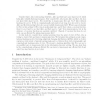Free Online Productivity Tools
i2Speak
i2Symbol
i2OCR
iTex2Img
iWeb2Print
iWeb2Shot
i2Type
iPdf2Split
iPdf2Merge
i2Bopomofo
i2Arabic
i2Style
i2Image
i2PDF
iLatex2Rtf
Sci2ools
ICML
2006
IEEE
2006
IEEE
Learning to impersonate
Consider Alice, who is interacting with Bob. Alice and Bob have some shared secret which helps Alice identify Bob-impersonators. Now consider Eve, who knows Alice and Bob, but does not know their shared secret. Eve would like to impersonate Bob and "fool" Alice without knowing the secret. If Eve is computationally unbounded, how long does she need to observe Alice and Bob interacting before she can successfully impersonate Bob? What is a good strategy for Eve in this setting? If Eve runs in polynomial time, and if there exists a one-way function, then it is not hard to see that Alice and Bob may be "safe" from impersonators, but is the existence of one-way functions an essential condition? Namely, if one-way functions do not exist, can an efficient Eve always impersonate Bob? In this work we consider these natural questions from the point of view of Ever, who is trying to observe Bob and learn to impersonate him. We formalize this setting in a new computational lea...
Related Content
| Added | 17 Nov 2009 |
| Updated | 17 Nov 2009 |
| Type | Conference |
| Year | 2006 |
| Where | ICML |
| Authors | Moni Naor, Guy N. Rothblum |
Comments (0)

